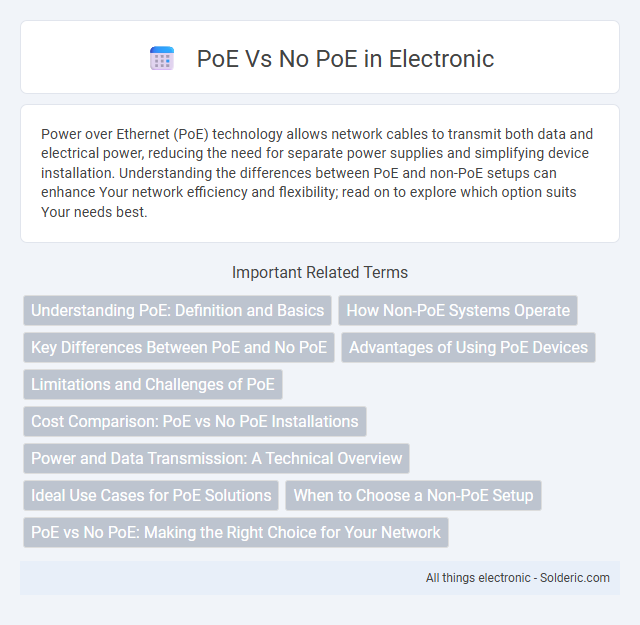Power over Ethernet (PoE) technology allows network cables to transmit both data and electrical power, reducing the need for separate power supplies and simplifying device installation. Understanding the differences between PoE and non-PoE setups can enhance Your network efficiency and flexibility; read on to explore which option suits Your needs best.
Comparison Table
| Feature | PoE (Power over Ethernet) | No PoE |
|---|---|---|
| Power Supply | Delivers power and data via a single Ethernet cable | Requires separate power source and Ethernet cable |
| Installation | Simplified, fewer cables needed | More complex, additional power wiring required |
| Cost | Higher initial cost for PoE-enabled devices and switches | Lower device cost but higher installation expenses |
| Flexibility | Easier to deploy in locations without power outlets | Limited to locations with nearby power supply |
| Common Uses | IP cameras, VoIP phones, wireless access points | Standard network devices needing separate power |
| Power Limits | Typically up to 30W (PoE), 60W (PoE+), 90W (PoE++) | Unlimited based on power adapter rating |
Understanding PoE: Definition and Basics
Power over Ethernet (PoE) enables network cables to carry electrical power alongside data, simplifying installation and reducing cable clutter in devices like IP cameras, VoIP phones, and wireless access points. Unlike traditional setups requiring separate power adapters, PoE delivers both power and data through a single Ethernet cable, ensuring efficient and centralized power management. Understanding PoE's basic standards, such as IEEE 802.3af and 802.3at, highlights its ability to provide varying power levels depending on device needs.
How Non-PoE Systems Operate
Non-PoE systems operate by requiring separate power sources for each network device, relying on individual power adapters or centralized power supplies. Data transmission and power delivery occur independently, often increasing cable complexity and installation costs. This separation can limit deployment flexibility and complicate network expansion compared to PoE-enabled setups.
Key Differences Between PoE and No PoE
Power over Ethernet (PoE) delivers electrical power alongside data through a single Ethernet cable, simplifying installation and reducing the need for separate power supplies, unlike No PoE systems which require distinct power connections. PoE supports devices such as IP cameras, VoIP phones, and wireless access points by providing both connectivity and power simultaneously, whereas No PoE setups necessitate additional wiring and power adapters. Network infrastructure with PoE offers enhanced flexibility, cost savings, and streamlined management compared to traditional No PoE networks that rely on separate power solutions.
Advantages of Using PoE Devices
PoE (Power over Ethernet) devices simplify network infrastructure by delivering both data and power through a single Ethernet cable, reducing the need for separate power supplies and outlets. PoE enhances installation flexibility, allowing you to position devices like IP cameras, wireless access points, and VoIP phones in optimal locations without worrying about nearby power sources. This technology also improves safety and reliability by using low-voltage power, minimizing electrical hazards and enabling centralized power management for better network control.
Limitations and Challenges of PoE
Power over Ethernet (PoE) faces limitations such as power delivery distance constraints, typically capped at 100 meters, and limited wattage output that may not support high-power devices. Challenges include increased cable weight and heat dissipation issues, which can affect network performance and equipment longevity. Your network design must account for these factors to ensure reliable PoE deployment without compromising device functionality.
Cost Comparison: PoE vs No PoE Installations
PoE installations typically reduce costs by eliminating the need for separate power cabling and outlets, enabling data and power transmission over a single Ethernet cable. No PoE setups often incur higher installation expenses due to additional electrical wiring, power adapters, and associated infrastructure. You can achieve significant savings in labor, materials, and maintenance with PoE, making it a cost-efficient choice for deploying network devices.
Power and Data Transmission: A Technical Overview
Power over Ethernet (PoE) technology enables simultaneous transmission of electrical power and data over a single Ethernet cable, reducing the need for separate power sources and simplifying network installations. Non-PoE systems require distinct cabling for power and data, which can increase complexity and installation costs. PoE standards, such as IEEE 802.3af and IEEE 802.3at, support power delivery up to 30W and 60W respectively, while maintaining high-speed data transfer, making PoE ideal for devices like IP cameras and wireless access points.
Ideal Use Cases for PoE Solutions
Power over Ethernet (PoE) solutions are ideal for environments requiring simplified infrastructure and flexible device placement, such as IP cameras, VoIP phones, and wireless access points. PoE enables single-cable delivery of data and power, reducing installation costs and enhancing scalability in office buildings, smart homes, and industrial automation. Non-PoE setups suit applications with dedicated power sources or high power demands outside PoE standards.
When to Choose a Non-PoE Setup
Choosing a non-PoE setup is ideal when your devices are already powered independently or when power sources are readily available near each device. This option can reduce costs and complexity in installations where network and power cabling need to be separated. Your network may benefit from non-PoE if flexibility in power management or longer cable runs without power constraints are priorities.
PoE vs No PoE: Making the Right Choice for Your Network
Power over Ethernet (PoE) technology combines data and power transmission over a single Ethernet cable, simplifying network installations and reducing the need for separate power supplies. In contrast, No PoE setups require dedicated power sources for devices, increasing wiring complexity and installation costs. Your choice between PoE and No PoE should consider factors like device compatibility, installation environment, and scalability to ensure efficient network performance and management.
PoE vs No PoE Infographic

 solderic.com
solderic.com